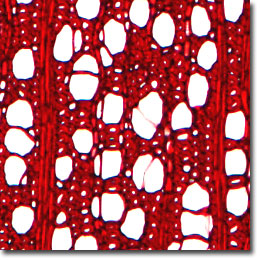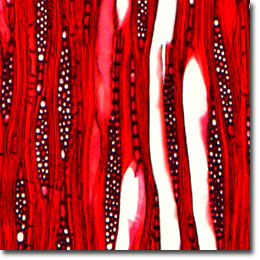The Black Tupelo
Black Tupelo (Nyssa sylvatica; also known as the Sour Gum, Black Gum and Pepperidge) is a hardwood tree that grows primarily in the eastern United States from Maine south to Texas and Missouri. This tree highlights the Indian summers of the autumn landscape, painting the forests with foliage hues that range from deep red to luminous orange and yellow. The sapwood is white (often with a grayish hue) and gradually merges into the darker greenish or brownish gray heartwood.

Cross Section

Radial Section

Tangential Section
Members of the tupelo family often attain a height of 80 to 85 feet and occasionally taller in the wild, and features horizontally oriented branches that droop gradually at the ends. The leaves range from three to five inches long and are broad with a pointed tip, but lack marginal teeth. This native tree is ideal for moist sites, but will grow well in dry soil.
Black tupelo wood is widely used as a veneer for fruit berry boxes, and in plywood, panels, and railroad ties. The lumber is also used for boxes, crates, pallets, and often for concealed furniture parts. Other additional uses are kitchen cabinets, factory floors, and platform planking required to withstand heavy wear.
Microscopic examination of iron-alum hematoxylin and safranin stained thin sections (see the digital images presented above) reveals a porous, diffuse wood with scalariform perforation plates and numerous vessels. Spiral thickening is occasionally present, but restricted to the tapering ends of the vessel elements. Inter-vessel pits occur in transverse rows and range in size from 5 to 12 micrometers, with an oval-rectangular shape. Fiber tracheids are moderately thick-walled and medium to coarse in texture. The rays are unstoried, heterocellular, and 1 to 4 seriate.